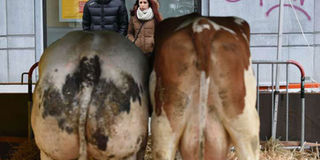Milk farmers sour as prices nose dive

People look at cows displayed in an enclosure during a farmer's demonstration to protest against falling food prices in Brussels on March 14, 2016. The European Union voiced support on March 14 for temporary cuts in milk production by farmers in member states in a bid to reverse the plunge in prices that has shaken the dairy industry. PHOTO | AFP
What you need to know:
- Last year the European Union finally got rid of its three-decade old milk production quotas that it had imposed to eliminate the milk lakes and butter mountains that had plagued the bloc’s farmers in the 1980s.
- In France all farmers are now selling milk at a price lower than their costs.
- In March, the European Commission allowed member states to temporarily cut production on a voluntary basis as an emergency exception to rules guaranteeing economic competition.
RENNES, FRANCE
A surge in milk production since the EU lifted milk quotas has skimmed profits for dairy farmers, leaving them sour as authorities struggle to get to grips with the crisis.
Last year the European Union finally got rid of its three-decade old milk production quotas that it had imposed to eliminate the milk lakes and butter mountains that had plagued the bloc’s farmers in the 1980s.
While farmers in several EU countries had been looking forward to tapping into rising demand for dairy products in developing countries, particularly in China, that growth slowed and there was soon a glut on the world market.
“Europe’s responsibility is overwhelming in the surge” in milk available on the global market, said Christophe Perrot, an economist at the Livestock Institute in Paris.
“Since 2013, the EU has supplied an extra 10 million tonnes on a market of 66 million tonnes,” he said at a recent farmers conference in the western French city of Rennes.
This has led to a slump in prices — by a fifth to a third — that has hammered farmers across the globe.
In France all farmers are now selling milk at a price lower than their costs.
Meanwhile in New Zealand, the world’s top exporter, 80 per cent of farmers are selling at a loss, according to the central bank.
In March, the European Commission, the executive of the 28-nation bloc, allowed member states to temporarily cut production on a voluntary basis as an emergency exception to rules guaranteeing economic competition. But milk production has continued to climb.
The issue is likely to dominate a meeting of EU agricultural ministers on Monday and Tuesday, but EU leaders are only expected to heap pressure on the commission, the bloc’s executive body, to step up its efforts.
According to a draft seen by AFP, EU leaders will call on “the commission to urgently implement all necessary support measures including, where appropriate, financial support to assist farmers...”
However, farmers meeting here at a recent peasants confederation conference want a full return to quotas, believing voluntary measures will be insufficient.
“We need mandatory production controls”, as is possible under EU rules, said Laurent Pinatel, a spokesman for the Farmers Confederation. Getting rid of the overproduction won’t be easy. Milk production shot up 4.3 per cent overall in the EU in the 2015-2016 season, the first without quotas, according to Perrot.
And cooperation may also be difficult to achieve.
In major producer countries like Germany, France and Britain, the milk processors may tend to adjust their purchases to market conditions, particularly their more profitable domestic markets.





